#manjushri
Explore tagged Tumblr posts
Text
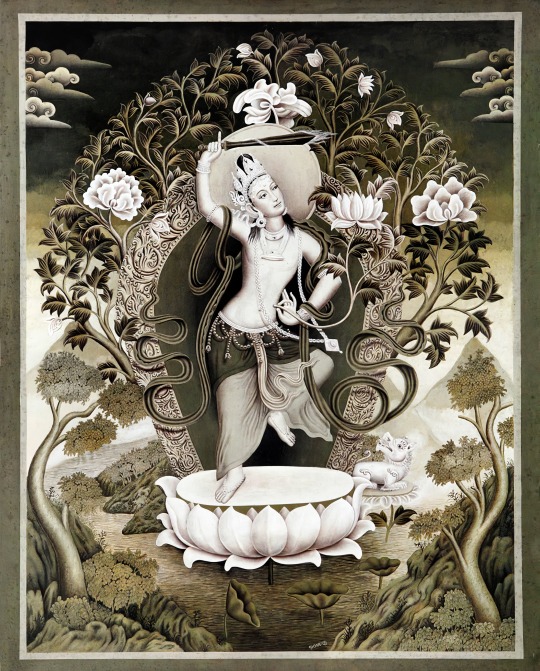
LDSR upscaled
under general devotional replication protocols
(from Mahayana art & assuming it applies to open reposting)
Manjushri (femme)
2 notes
·
View notes
Text
Me, staring at the "Nezha is eternally 12/Nezha is often depicted as a kid so he's just a kid and nothing else" crowd: man, have you heard of Child Manjushri a.k.a. Wenshu Tongzi
(This is totally not an excuse for me to find cool statue pictures and talk iconography)
So, here is Bodhisattva Manjushri in his standard "graceful aristocratic prince" form, riding his azure lion. The statue in the picture doesn't have it, but oftentimes, he'll also be holding a flaming sword that symbolizes wisdom's ability to cut through ignorance and delusions.
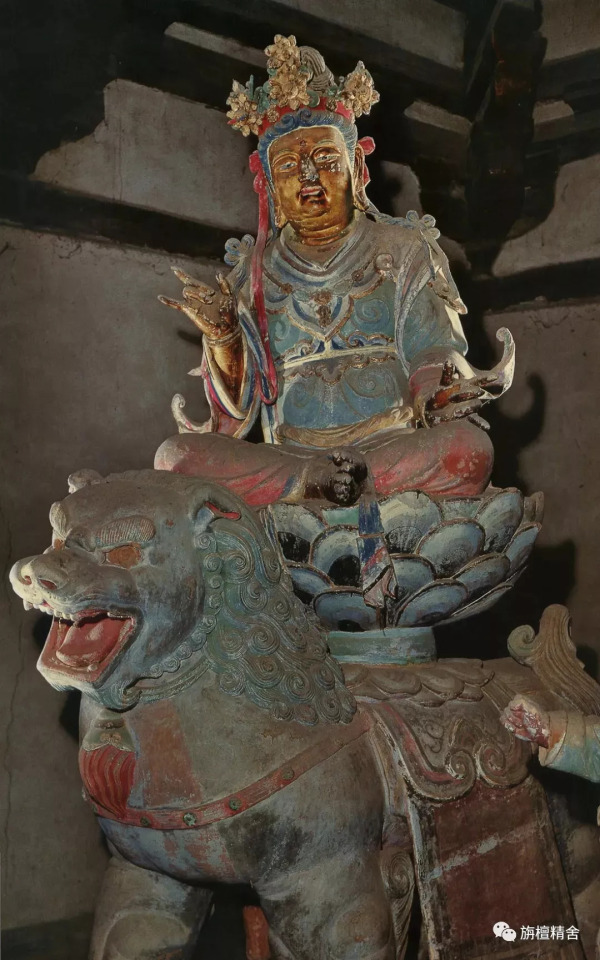
This is "Holy Old Monk Manjushri", a variant that I came across a few times while temple-touring, but couldn't find many good online pictures of. It seemed like a thing that was popular around Mt. Wutai, based on the "Buddha-palita met Old Man Manjushri" tale. Sometimes his BFF Samantabhadra is depicted as an old man too, for matching purposes.
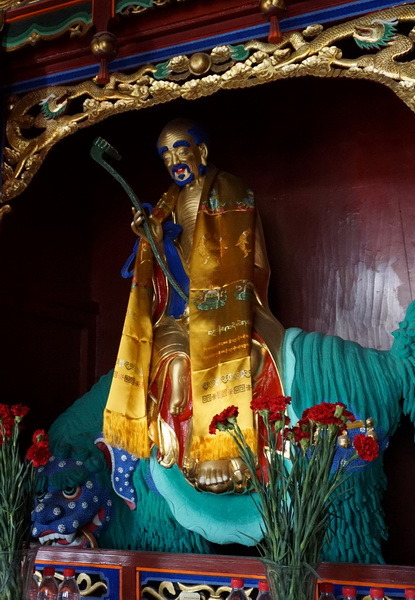
And this is Child Manjushri, with his five hair buns, often worshipped in an esoteric context. On Mt. Wutai, there are five major temples atop five peaks, each worshipping a different form of Manjushri, and the "middle peak" temple has a Child Manjushri in their main hall. Like, it's far from the most common variant, but neither is it this super obscure form that no longer enjoys active worship.
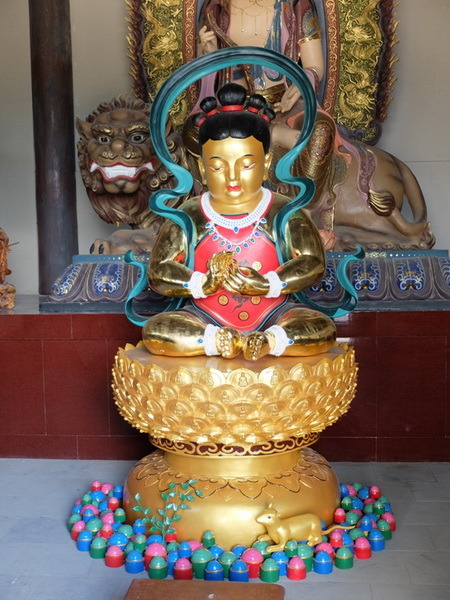
Lastly, just for fun: this is Yamantaka, a guardian deity/Wisdom King, who, in Tibetan Buddhism, is believed to be Manjushri's wrathful form.
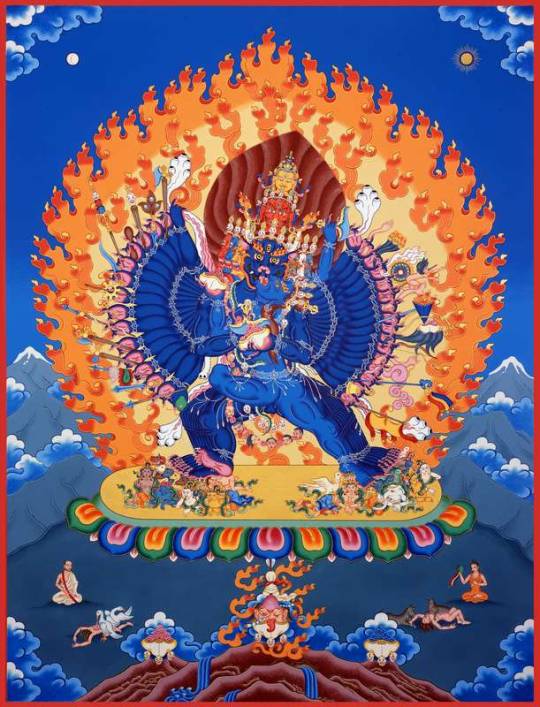
If you wouldn't call Manjushri "the eternal child Bodhisattva" just because he has a child form, why would you say Nezha is an eternal child when he, too, has both child and adult forms?
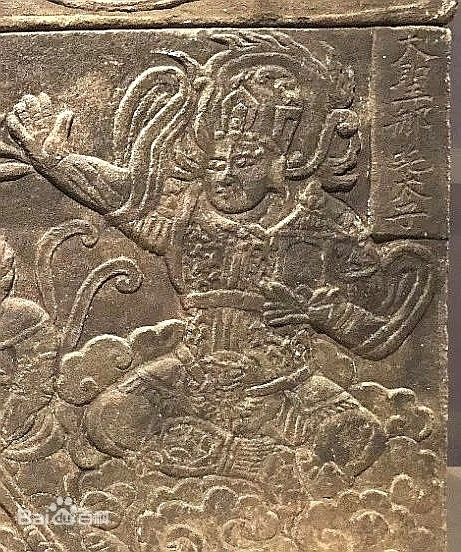
Even though Nezha's child form is vastly more popular and well-known than Child Manjushri, I think my point still stands: A deity is capable of having multiple manifestations, of varying ages and appearances, each fulfilling a particular function and niche——none of which is the "One True Form TM", just different clothes they wear based on occasions and audiences.
To stretch the analogy a little, Manjushri's child form is the formal dress he puts on before attending a religious event, while Nezha's child form is the lotus T-shirt he wears a lot while appearing on TV, to the point it becomes his most iconic attire.
This doesn't mean he only has a single shirt, for goodness sake, and using his child form as evidence for the "eternal child" claim is like saying Nezha's only allowed to wear that one shirt and nothing else.
#chinese mythology#chinese religion#buddhism#manjushri#bodhisattva#nezha#buddhist art#fandom discourse#lego monkie kid#...tagging lmk because where else would I see the “eternally 12” thing proliferate#this will be my only two cents on the topic#barring answering asks that are specifically about Nezha in FSYY/JTTW
156 notes
·
View notes
Text

3 notes
·
View notes
Text
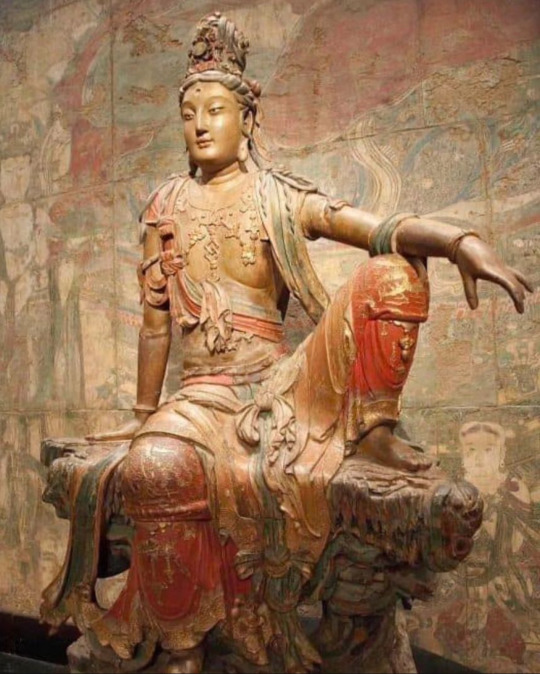
"My friends will become nothing,
My foes will become nothing,
I too will become nothing.
Just like a dream experience,
whatever things I enjoy will not be seen again.
The Buddhas neither wash ill deeds away with water, Nor remove beings suffering with their hands.
Beings are released through the teachings of the truth, the final reality.
Thus by the virtue of all that I have done,
May the pain of all living beings be cleared away."
~ Shantideva
From: «The Way of the Bodhisattva»
#shamatha#shantideva#buddha#buddhist#buddhism#dharma#sangha#mahayana#zen#milarepa#tibetan buddhism#thich nhat hanh#enlightenment spiritualawakening reincarnation tibetan siddhi yoga naga buddha#amitaba buddha#Avalokiteshvara#Dzogchen#dali lama#dzambala#buddha samantabhadra#manjushri#vajrasattva#vipassana#vajrapani#vajrayana#bodhidharma#merit
138 notes
·
View notes
Note
Hey!
Did you know that in the original story azure was not only known as the “lion-lynx demon” but was also the steed of manjusri?
Also! I heard that in the original Chinese translation he was actually female! Which would kinda make sense since he’s most likely castrated and would’ve lost his mane if he was a guy.
Anyway, how would Li Jing and even azure react to this? Is it cannon within your story?
While that is HILARIOUS to think about, Azure being female would not be canon. The whole castration thing was kinda fixed after the JE died and his magic, well, magically fixed azure.
Also yes! I was aware of the first bit! Manjusri is a very happy grandparent!
#lego monkie kid#lmk aus#lmk li jing#lmk au#lionsword#lego monkie kid au#lmk azure lion#lmk#ask rec#ask answered#asks open#lmk fan children#fan kids#manjushri
9 notes
·
View notes
Text

En la novela, Azure Lion es la mascota del boddishatva Manjushri. Simpre he querido ver un dibujo de ellos juntos. Me pregunto como hubiera sido su dinamica si el hubiera existido en LMK. Ya que el lore de Azure es diferente en LMK
10 notes
·
View notes
Note
I am a little confused. Someone on twt says that the lion that takes the place of King Wuji and the Azure Lion that is with his sworn brothers are two different lions and are not the same, however, some articles say that they are the same.
I’ve seen that as well! I personally never heard of this take before but I asked a friend and they told me that this is a real theory. I'm not sure how popular the two-lion theory is since I've never seen anyone else ever talk about it but I'll explain it here.
Two Lions theory - Wukong didn’t mention anything to Azure Lion when they met in the Camel Ridge arc. He mentioned nothing of their first fight in the Wuji Kingdom and this makes it strange he wouldn’t at least reference this. The master also says nothing of his Lion running away in the few short years that he was the one to release him from the Wuji kingdom. Never referenced in the book and thus it didn't happen.
Same Lion theory - Bodhisattva are only known for having a single beast they ride or their Diting and it would be strange that Manjushri has two of the exact same Lion. While other Bodhisattvas like GuanYin are connected to multiple animals (she has a pet goldfish and her Diting is a wolf) but only Manjushri has the same animal. He is never mentioned on having different animals and thus it is the same animal but he ran away the second time and that is why it wasn't mentioned.
In the most likely case, you have to think of it as a more out-of-story reason as to why there were multiple stories of Manjushri's animal companion in the story and they are both meant to be based on the same animal. Wu Cheng'en didn't write Xiyouji himself, he took what existing stories that were already there and was the man to make it into a single-story compilation. The stories most likely used the same Lion since Manjushri is an old and well-known figure but Wu Cheng'en still added both since it could work. Wu Cheng’en most likely didn’t bother to add any acknowledgment that these were the same beast within the story because it wasn't contradicting anything in the story for having this animal commit two crimes there would be no reason to not add both stories.
That being said I personally believe they are the same Lion even if it was overlooked to acknowledge how the same beast commits two different crimes. I think that plot wise it doesn’t disqualify that this Lion could have done both as unlikely as it is. The first time being out of his master's wish and the second time being of his own volition. I never heard of the Two Lion Theory being a popular thing and not sure if other people even heard about it but maybe @journeytothewestresearch knows something.
#anon ask#anonymous#anon#jttw#journey to the west#xiyouji#ask#azure lion#lion lyx demon#lion demon#Manjushri#Bodhisattva Manjushri
7 notes
·
View notes
Text
Monju, the Bodhisattva of Wisdom, and Lion
Manjushri, the bodhisattva of wisdom known as Monju in Japan, sits on the back of his lion. https://wp.me/pFy3u-8AI
Monju on a LionShūsei Japanese, late 15th century Manjushri, the bodhisattva of wisdom known as Monju in Japan, sits cross-legged on the back of his lion. Monju appears as a youth in flowing robes, his hair worn long and loose; one of his attributes, a scepter, is placed casually on the ground before him. Although it is a decidedly carefree interpretation, the iconography seen here is consistent…
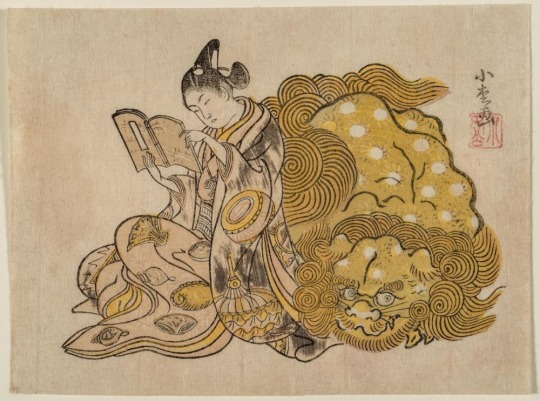
View On WordPress
3 notes
·
View notes
Text
Manjushri
Manjushri is one of the most important iconic figures in Mahayana Buddhism and is known as the Bodhisattva of Great Wisdom. He is worshipped as the "Meditational Deity" in Esoteric Buddhism. The Sanskrit name of Manjushri is "Prajna," which means "gentle glory," "He who is noble and gentle," "soft glory," "Wondrous Auspiciousness," and so on. Buddhist monasteries' meditation halls, libraries, and study rooms often consist of images of Manjushri Bodhisattva. Read more at: Manjushri Bodhisattva | Four Great Bodhisattva in China


1 note
·
View note
Text






Chikurinji (竹林寺) - Temple 31 of the Shikoku Pilgrimage
If you’re walking the Shikoku 88 Temple Pilgrimage, Chikurinji in Kochi is a must-visit. Built in 724, this historic temple is dedicated to Monju Bosatsu (Manjushri), the bodhisattva of wisdom. Many students visit here to pray for academic success before exams.
🏯 Highlights:
A stunning five-story pagoda painted in bright red.
A 14th-century Edo-style garden (National Place of Scenic Beauty).
A Chinese-influenced temple complex with ponds and a stained-glass dome in Meguri no Mori.
Autumn foliage: More maples than bamboo, creating incredible golden and crimson hues.
📍 Location: Kochi Prefecture, Shikoku, Japan 📞 Phone: +81 88-882-3085 🌏 Website: http://chikurinji.com/ 📍 Map Link: Google Maps 📘 Facebook: 竹林寺 Facebook Page
Who’s visited Chikurinji before? Any experiences or tips for fellow pilgrims? 🏯👣
0 notes
Text






Chikurinji (竹林寺) - Temple 31 of the Shikoku Pilgrimage
If you’re walking the Shikoku 88 Temple Pilgrimage, Chikurinji in Kochi is a must-visit. Built in 724, this historic temple is dedicated to Monju Bosatsu (Manjushri), the bodhisattva of wisdom. Many students visit here to pray for academic success before exams.
🏯 Highlights:
A stunning five-story pagoda painted in bright red.
A 14th-century Edo-style garden (National Place of Scenic Beauty).
A Chinese-influenced temple complex with ponds and a stained-glass dome in Meguri no Mori.
Autumn foliage: More maples than bamboo, creating incredible golden and crimson hues.
📍 Location: Kochi Prefecture, Shikoku, Japan 📞 Phone: +81 88-882-3085 🌏 Website: http://chikurinji.com/ 📍 Map Link: Google Maps 📘 Facebook: 竹林寺 Facebook Page
Who’s visited Chikurinji before? Any experiences or tips for fellow pilgrims? 🏯👣
#ShikokuPilgrimage#88Temples#Chikurinji#KochiJapan#Manjushri#JapaneseTemples#Pilgrimage#japan photo now#japan destinations#japan vacation#japan photos#japan of insta#japan#photography
0 notes
Text
Chapter 39: The Mystery of the Blue Feline
"Is it the same lion, or a different lion?"
Hmmm…a mystery for the ages.
Context: Manjusri/Wenshu's Azure Lion appears twice in JTTW, first here, then in the more well-known Lion Camel Ridge arc, both of which ended with Wenshu showing up and dragging his steed back to Mt. Wutai.
On the former occasion he was actually a good king, despite pushing the actual king into a well and taking his place, as stated by Wenshu himself—a stark contrast to his later apperance, where he had gone full demon-king and started eating people, and the Azure Lion of LCR shows no sign of having recognized SWK from before.
This naturally rise some questions. Are these two the same lion? If not, is Wenshu basically the Big Cat Dad of Bodhisattvas, who adopted a whole pride of lion cubs as his steeds /j
Well…the best theory I can come up with is that JTTW novel is a compilation of Journey tales over the years, and two stories happened to involve Manjusri's lion and the final author-compiler just put both in, without much thoughts about making them logically consistent.
Like, JTTW in folk storytelling and opera format had a lot of "episodes" that could be told in different places and time, out of sequence, with only the barest knowledge of context needed.
And unlike novel written by one author from the beginning and exists first and foremost in book format, if you are a Ming Precious Scroll preacher or opera play writer, you can tell Lion Story A in one place and Lion Story B in another place and the two group of audiences would never overlap.
Or, you could tell both to a single group of audiences, but bc so much time have passed between the two performances, they had already forgotten about the previous one.
The "Wuji Kingdom Lion" story certainly appears first in the evolution of the JTTW story cycle, though: in the folk opera collection 礼节传簿, there was an excerpt of a play's act names called "Tripitaka Seeks the Scripture in the West" (唐僧西天取经), which already included the "Wenshu Subdues the Lion at Wuji Kingdom" story.
Also, there was an entire Zaju play about Wenshu subduing the lion by the Ming prince Zhu Youdun that I could not find any digital version of, only summaries, and Nezha and his embroidered ball was somehow involved.
Sidenote, we also see how SWK's golden vision has limits here. When the lion transforms into Tripitaka, SWK had trouble telling them apart, and stated outright that it was because "his Qi and body are the same" (气体相同). This supports the theory that SWK's golden vision doesn't actually see through demonic glamor and perceive their true forms, but merely the aura they are radiating.
On a more annoying note: popular modern reading of JTTW tends to see Wenshu as this petty asshole in the Wuji Kingdom chapter. "Sure, the king might have dunked a disguised Bodhisattva into the palace canal for three days, but you insulted him first, and besides, that's no reason to make your pet murder him and leave his body at the bottom of a well for three years!"
Which…is a lot of presentism, and people just not getting the saying that "Each peck, each drink, is predetermined" (一饮一啄,莫非前定). It is very much going by the popular understanding of karmic retribution, where every consequences have a cause.
But I do have a HC about this. In the text, the King of Wuji was known as a generous and pious ruler, who greatly venerated Buddhism and priests, and it was because of this that the Buddha sent Wenshu to evaluate him for potential Arhat-hood.
Wenshu, in the disguise of a poor priest, met the king, got dunked into a canal for cheek, yadda yadda yadda. Fast-forward, a great drought had descended upon Wuji kingdom, and no amount of prayers seemed to help, until Azure Lion showed up in the disguise of a Daoist sage, summoned a much-needed storm, and became the king's sworn brother.
But what if Wenshu had come to the kingdom with another goal in mind?
As the wisest Bodhisattva, he knew a drought was imminent, and if the king was virtuous and faithful enough to be a potential candidate for Arhat-hood, he would certainly use this knowledge well. Yet, upon a closer observation, cracks began to show.
Sure, the king loved Buddhism, but his way of showing it was building all these lavish temples and golden statues and spoiling the clergy, with no regards for the burden placed on commoners and the corruption he fostered. As such, his kingdom would be woefully unprepared for a natural disaster.
Which was exactly what Wenshu told him; just like how Vows are but empty promises without Practice, Practice without Wisdom and Mercy, without the awareness of causes and consequences and what people truly need, is a receipt for disaster. If you spent half the money you used to construct these temples on irrigation projects and new granaries, you'd have done more good than all the prayers of your monks combined.
Annnd the king didn't take it well, bc how dare this lowly monk bit the hand that fed him, and, egged on by some equally pissed-off monks, ordered the fateful three-day-long dunking. If the monk was a regular monk he wouldn't have survived that, and in true karmatic fashion, the attempted murder was going to come back to him.
That tangent aside: when Wenshu defended his steed by saying it had not committed any crimes as a king after the murder-replace thing, SWK was like "But he sleeps with the queen while disguised, right, how's that for 'No crimes committed'?" And Wenshu responded with "Oh no worries, my pet is neutered", and Bajie actually checked by trying to grab its nonexistent balls…
Funny. As. Hell.
@journeythroughjourneytothewest
12 notes
·
View notes
Text
"Normally we operate under the deluded assumption that everything has some sort of true, substantial reality. But when we look more carefully, we find that the phenomenal world is like a rainbow — vivid and colorful, but without any tangible existence.
When a rainbow appears we see many beautiful colors - yet a rainbow is not something we can clothe ourselves with, or wear as an ornament; it simply appears through the conjunction of various conditions. Thoughts arise in the mind in just the same way. They have no tangible reality or intrinsic existence at all. There is therefore no logical reason why thoughts should have so much power over us, nor any reason why we should be enslaved by them."
- Kyabje Dilgo Khyentse Rinpoche
#dilgo khyentse rinpoche#buddha#buddhist#buddhism#dharma#sangha#mahayana#zen#milarepa#tibetan buddhism#thich nhat hanh#Padmasambhava#Guru Rinpoche#enlightenment spiritualawakening reincarnation tibetan siddhi yoga naga buddha#amitaba buddha#Avalokiteshvara#chenrezik#Dzogchen#dali lama#dzambala#rainbow body#buddha samantabhadra#manjushri#bodhidharma#vajrasattva#vipassana#vajrapani#shantideva#Longchenpa
45 notes
·
View notes
Note
The brotherhood have a "family reunion" and things get a little intense.
Someone (unintentionally) insults newborn Mocha's picture, saying she looks gross and wrinkly (she was FRESH out the womb when the picture was taken).
...
Azure ends up in air jail.
Jing would be too, but he's still physically recovering from birthing Mocha.
BWAHAHAHAHAHA
Oh man that would be great 🤣 Just imagining Manjushri just casually holding azure by his own scruff the way that azure does to Nezha and the kids while poor azure tries to attack whatever unlucky shmuck dare make such a moment!
Nezha isn’t far behind, only restrained by the fact that he has to keep Jing in his damn wheel chair (hey, mocha was big) instead of beating up the asshole himself.
Imagine making a single off handed comment that was bad enough for the Future Jade emperor, his father(the mama), and Manjushri’s steed to all come at you. With the only thing keeping you alive being the the mama’s inability to get out of his wheelchair and Manjushri holding his steed away.
Jing: “Let me at him-“
Nezha: “Dad please you literally can’t walk-“
Azure: “HISSSSSS”
#lego monkie kid#lmk aus#lmk li jing#lmk au#lionsword#lego monkie kid au#lmk nezha#lmk azure lion#lmk#ask rec#asks open#anon ask#answered asks#mocha#baby mocha#manjushri#lmk fan children#fan kids
7 notes
·
View notes
Text








Chikurinji (竹林寺) - Temple 31 of the Shikoku Pilgrimage
If you’re walking the Shikoku 88 Temple Pilgrimage, Chikurinji in Kochi is a must-visit. Built in 724, this historic temple is dedicated to Monju Bosatsu (Manjushri), the bodhisattva of wisdom. Many students visit here to pray for academic success before exams.
🏯 Highlights:
A stunning five-story pagoda painted in bright red.
A 14th-century Edo-style garden (National Place of Scenic Beauty).
A Chinese-influenced temple complex with ponds and a stained-glass dome in Meguri no Mori.
Autumn foliage: More maples than bamboo, creating incredible golden and crimson hues.
📍 Location: Kochi Prefecture, Shikoku, Japan 📞 Phone: +81 88-882-3085 🌏 Website: http://chikurinji.com/ 📍 Map Link: Google Maps 📘 Facebook: 竹林寺 Facebook Page
Who’s visited Chikurinji before? Any experiences or tips for fellow pilgrims? 🏯👣
#ShikokuPilgrimage#88Temples#Chikurinji#KochiJapan#Manjushri#JapaneseTemples#Pilgrimage#japan#photography#shikoku#dronephotography
0 notes
Text

Bodhisattva of Wisdom (Manjushri), 1400s, Nepal Gilt bronze with precious and semiprecious stones, gum tempera, and cold gold, 78.1 x 67.6 cm Cleveland Museum of Art
This image depicts one of the main bodhisattvas, beings only one stage away from full enlightenment. Because the historical Buddha was a prince prior to his renunciation and life as a wandering ascetic, bodhisattvas are depicted as royal princes. This example has the sharp features, sweet expression, and crisp details characteristic of images made in Nepal during the 1400s.
In his upraised right hand Manjushri holds the hilt of a sword that, like wisdom itself, metaphorically cuts through and defeats ignorance. His lower, rear left hand grasps a bow, once probably strung with a wire. Also missing is the arrow that he likely held in his lowered right hand. Arrows were often symbols for mantras, or strings of syllables thought to have the power to focus the mind and work like missiles to destroy negativity and affliction. The gesture of his lowered left hand indicates the transmission of Buddhist teachings. The lotus stem that rises at the left elbows originally held a book of sutras.
This figure is in the yogic posture of meditation with the big toe flexed in concentration. Yoga is of central importance in tantric Buddhism, because high-level practitioners are able to discipline the body to such an extent that the mind can also be controlled. via
#manjushri#bodhisattva#deity#far east#sculpture#antiquities#buddhism#15th century#nepal#art history#yoga#tantric buddhism
1 note
·
View note